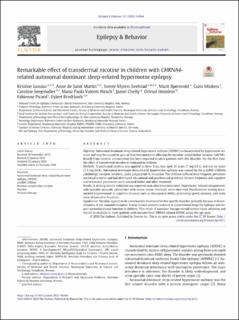| dc.contributor.author | Lossius, Kristine | |
| dc.contributor.author | de Saint Martin, Anne | |
| dc.contributor.author | Myren-Svelstad, Sverre | |
| dc.contributor.author | Bjørnvold, Marit | |
| dc.contributor.author | Minken, Guro | |
| dc.contributor.author | Seegmuller, Caroline | |
| dc.contributor.author | Valenti Hirsch, Maria Paola | |
| dc.contributor.author | Chelly, Jamel | |
| dc.contributor.author | Steinlein, Ortrud | |
| dc.contributor.author | Picard, Fabienne | |
| dc.contributor.author | Brodtkorb, Eylert | |
| dc.date.accessioned | 2020-05-15T08:24:22Z | |
| dc.date.available | 2020-05-15T08:24:22Z | |
| dc.date.created | 2020-03-18T09:14:15Z | |
| dc.date.issued | 2020 | |
| dc.identifier.issn | 1525-5050 | |
| dc.identifier.uri | https://hdl.handle.net/11250/2654578 | |
| dc.description.abstract | Objective
Autosomal dominant sleep-related hypermotor epilepsy (ADSHE) is characterized by hypermotor seizures and may be caused by gain-of-function mutations affecting the nicotinic acetylcholine receptor (nAChR). Benefit from nicotine consumption has been reported in adult patients with this disorder. For the first time, the effect of transdermal nicotine is evaluated in children.
Methods
Transdermal nicotine was applied to three boys, two aged 10 years (7 mg/24 h) and one six years (3.5 mg/24 h). Autosomal dominant sleep-related hypermotor epilepsy was caused by the p.S280F-CHRNA4 (cholinergic receptor, nicotinic, alpha polypeptide 4) mutation. The children suffered from frequent, persistent nocturnal seizures and had developed educational and psychosocial problems. Seizure frequency and cognitive and behavioral parameters were assessed before and after treatment.
Results
A striking seizure reduction was reported soon after treatment onset. Hypermotor seizures disappeared; only sporadic arousals, sometimes with minor motor elements, were observed. Psychometric testing documented improvement in cognitive domains such as visuospatial ability, processing speed, memory, and some areas of executive functions.
Significance
Nicotine appears to be a mechanistic treatment for this specific disorder, probably because of desensitization of the mutated receptors. It may control seizures resistant to conventional drugs for epilepsy and impact socioeducational function in children. This mode of precision therapy should receive more attention and should be available to more patients with uncontrolled CHRNA4-related ADSHE across the age span. | en_US |
| dc.language.iso | eng | en_US |
| dc.publisher | Elsevier | en_US |
| dc.rights | Navngivelse 4.0 Internasjonal | * |
| dc.rights.uri | http://creativecommons.org/licenses/by/4.0/deed.no | * |
| dc.title | Remarkable effect of transdermal nicotine in children with CHRNA4- related autosomal dominant sleep-related hypermotor epilepsy | en_US |
| dc.type | Peer reviewed | en_US |
| dc.type | Journal article | en_US |
| dc.description.version | publishedVersion | en_US |
| dc.source.volume | 106 | en_US |
| dc.source.journal | Epilepsy & Behavior | en_US |
| dc.identifier.doi | 10.1016/j.yebeh.2020.106944 | |
| dc.identifier.cristin | 1802157 | |
| dc.description.localcode | © 2020 The Authors. Published by Elsevier Inc. This is an open access article under the CC BY license (http:// creativecommons.org/licenses/by/4.0/). | en_US |
| cristin.ispublished | true | |
| cristin.fulltext | original | |
| cristin.qualitycode | 1 | |

